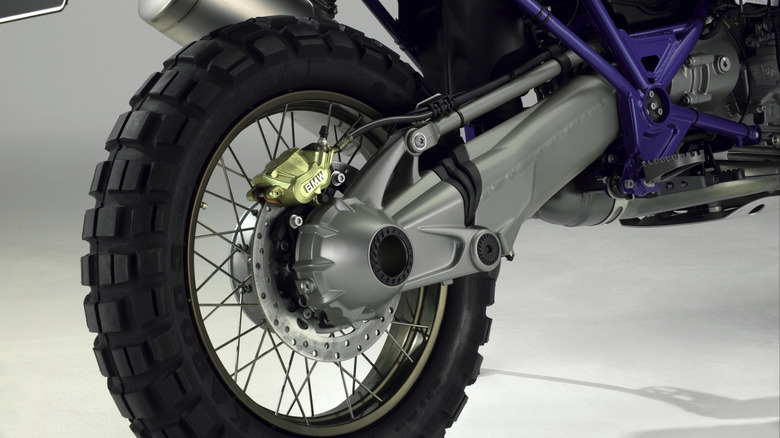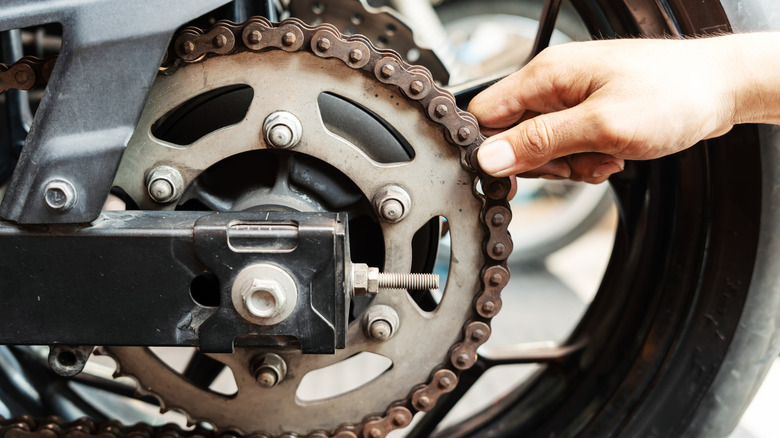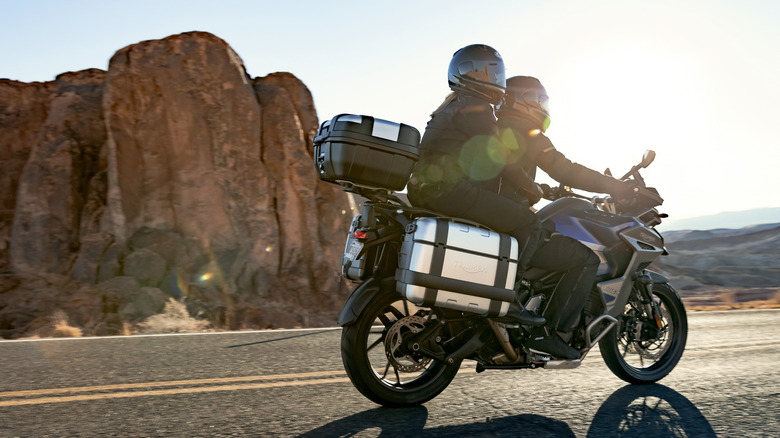What Is A Shaft Drive Motorcycle And Why Aren't They More Popular?
A chain is the most common form of drive on two wheels — not only motorcycles, but bicycles, too. This is not the only way to transmit power to the wheel, though. Some bikes use a shaft in the same way as a car, connecting the gearbox to a differential, which drives the wheel. A shaft drive is quieter, and needs less maintenance than a chain — but despite these advantages, shaft drives are not often seen on motorcycles due to their higher cost, higher weight, and lower efficiency.
Shaft-driven motorcycles have been around since 1901, finding commercial success with the launch of the underappreciated classic BMW R32 in 1923. The innovative flat-twin boxer engine and shaft drive on the early BMW motorcycles has since become inseparable from the brand, and set the template for virtually all BMW bikes that followed. Even today, a shaft driveline is commonly associated with European manufacturers like BMW and Moto Guzzi – or even Triumph in the U.K., with models like the Triumph Tiger 1200.
A third option is to use a belt drive, which has a toothed belt and pulley in place of a chain and sprocket. While smooth and quiet in operation, a belt drivetrain is more expensive than a chain drive, which has many advantages over a shaft or belt. The chain drive is the most efficient of the three, getting more power to the wheels at a lower cost, and with lighter weight. But it, too, has its disadvantages.
Chain drives are cheap, efficient, and easy to mod
On the plus side, a classic chain drive is less costly to manufacture and more efficient, not having to overcome the rotational inertia of a shaft. Those who race, mod, or off-road their bikes also see a benefit in how simple it is to change swing arms or gear ratios: You can simply fit different sized sprockets, with a greater or lesser number of teeth, and a chain to fit, thereby raising or lowering the gearing.
However, a chain drive requires ongoing maintenance, which includes cleaning, inspection, lubrication and adjusting the chain slack every 300 to 500 miles. Chains can stretch or break, while sprockets wear down and must be replaced. Back in late 1970s, this constant need for maintenance led some motorcycle manufacturers to offer shaft drives on their mid-sized bikes, for example the the Honda CX500 — a surprising favorite with modern-day bike customizers.
Custom classics aside, a mid-sized, shaft-drive motorcycle is a rare sight these days. It's been nearly half a century since Honda first wheeled its Moto Guzzi-inspired CX500 out onto our roads, and in that time innovations like X-ring seals have made bike chains quieter, lower maintenance, and longer lasting. Even a shaft-drive stalwart BMW is in on the action, with products like its "maintenance-free" chains making it harder for manufacturers to justify the additional costs needed to design and build shaft-drive motorcycles.
Shaft drives are still popular on big touring bikes
When it comes to the large-displacement tourers, manufacturers and riders alike prioritize low maintenance and comfort over cost and weight. The bulletproof indestructibility of a shaft drive make it a classic for large touring motorcycles, where power-to-weight downsides are minimized by the heft of the ride. Encased inside its sealed housing, a modern shaft drive can last a lifetime, even without regular maintenance.
Two out of 10 on our 2024 list of major sport touring bikes use shaft drive — the Yamaha FJR1300 ES and the BMW R1250. Compare that to the most comfortable motorcycles you can buy and we see twice as many — the Honda Gold Wing GL1800, BKW K 1600 GTL, Kawasaki Concours 14 ABS, and BMW R 1250 RT, suggesting shaft drive is not at all unpopular with the touring bike demographic.
In the U.S., Harley Davidson has favored belt drive since the mid-1980s. Strengthened with steel wire and Kevlar, a modern drive belt can last more than 60,000 to 100,000 miles, and is well suited to our highways. If a belt has to be replaced, the rear swing arm must come off, once the specific part has been ordered, and the replacement has arrived, that is. By contrast, a chain can be removed, repaired and replaced virtually anywhere on the planet, while a shaft drive may never need to be replaced at all.


